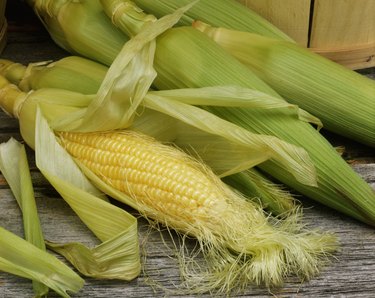
High-fructose corn syrup doesn't contain any more fructose than you'll get from table sugar, but since it has more fructose than its source -- corn starch -- it's called high-fructose. On the other hand, crystalline fructose truly is high in fructose. Both HFCS and crystalline fructose are used commercially to sweeten foods. They're also both sources of empty calories, so the American Heart Association recommends limiting the amount you consume.
Ingredient Comparison
Video of the Day
High-fructose corn syrup is made from corn starch, which consists entirely of glucose. After the starch is extracted, it goes through processing with enzymes that converts some of the glucose into fructose. As a result, the final product contains both sugars.
Video of the Day
Destined to be used as a sweetener, HFCS contains either 42 percent fructose or 55 percent fructose.
Manufacturers can also produce HFCS that has 90 percent fructose. When it has that much fructose, it can be put through additional processing to crystallize the syrup.
After the crystals are dried, the resulting product -- crystalline fructose -- is 100 percent pure fructose.
Commercial Uses
HFCS with 42 percent fructose doesn't interfere with natural flavors, so it's primarily used in baked goods, cereals, yogurt, ice cream and processed foods such as soups, condiments and canned fruits. HFCS-55 is used to sweeten soft drinks and other beverages, reports Biotechnology and Molecular Biology Review.
Crystalline fructose is also used to sweeten foods and beverages. Because fructose is naturally sweeter than sugars such as glucose and table sugar, crystalline fructose is one of the sweetest sugar substitutes available. The crystalline form also has some other commercial benefits: It improves texture and stability in baked goods and browns to create a nice color.
Metabolism Differences
High-fructose corn syrup is metabolized a little differently than crystalline fructose, but only because fructose follows a different path in your body than glucose.
The glucose portion of HFCS enters your bloodstream and can be used by cells throughout your body for energy. The fructose part of HFCS, and all of crystalline fructose, goes to the liver, where enzymes tend to turn it into fat.
Because fructose doesn't enter the bloodstream, it has a very small impact on blood sugar. By comparison, on the glycemic scale of zero to 100, glucose scores a 100, which means it significantly spikes blood sugar.
Recommended Intake
HFCS and crystalline fructose are both added sugars that contribute calories and can cause weight gain. The American Heart Association recommends women consume fewer than 6 teaspoons of added sugar daily, while men should limit their intake to no more than 9 teaspoons.
Even though fructose doesn't affect blood sugar, it has the potential to boost blood lipids such as triglycerides, so the American Diabetes Association does not recommend added fructose as a sweetener for people with diabetes.
That said, you don't need to worry about the fructose that naturally occurs in whole foods, such as fruits and vegetables. These foods are important sources of fiber and nutrients, and they don't provide enough fructose to cause concern, noted Diabetes Care in January 2008.
- U.S. Food and Drug Administration: High-Fructose Corn Syrup: Questions and Answers
- Sweeteners From Starch: Production, Properties and Uses; Larry Hobbs
- Fructose Information Center: Facts About Fructose
- Biotechnology and Molecular Biology Review: High Fructose Corn Syrup: Production, Uses and Public Health Concerns
- American Heart Association: Added Sugars
- Diabetes Care: Nutrition Recommendations and Interventions for Diabetes: A Position Statement of the American Diabetes Association
- Harvard Health Publications: Abundance of Fructose Not Good for the Liver, Heart
- Harvard Medical School: Glycemic Index and Glycemic Load of 100+ Foods